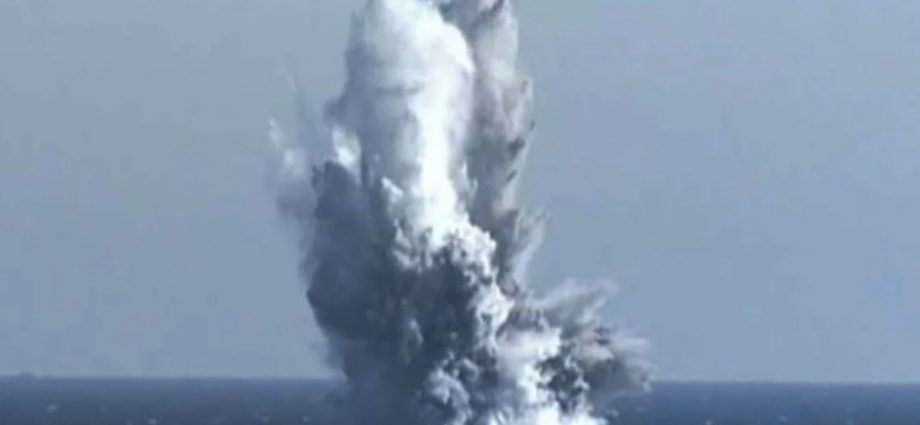North Korea is flexing its weapons of mass destruction (WMD) capabilities again with a new nuclear-armed underwater drone and nuclear-capable subsonic cruise missiles.
Last week, The Wall Street Journal reported that North Korean leader Kim Jong Un presided over tests of a new nuclear-armed underwater drone. This test demonstrated the weapon infiltrating enemy waters and then detonating to create a radioactive tsunami to destroy enemy ports and ships.
The WSJ report mentions that photos released by North Korea show Kim Jong Un smiling next to a torpedo-shaped object and an explosion over water.
CNN reports that the torpedo-shaped drone, dubbed “Haeil,” cruised in waters off North Korea’s eastern coast from March 21-23, running in figure-eight and oval patterns at 82 to 150 meters for 60 hours before detonating.
The Haeil has been under development since 2012, with 50 tests carried out over the past two years to test the weapon’s reliability, safety and lethality, according to North Korean state media.
However, the CNN report cites analysts that view the Haeil skeptically, as North Korea is well-known to exaggerate its military capabilities for deterrent effect.
North Korea also tested nuclear-capable subsonic cruise missiles around the same time as the Haeil test, with four missiles reportedly hitting targets in the Sea of Japan after flying figure-eight patterns of 1,500 and 1,800 kilometers.
The tests aimed to familiarize strategic cruise missile units to carry out tactical-level nuclear attacks, North Korean state media said.
North Korea’s Haeil is in philosophical line with Russia’s Poseidon nuclear-armed underwater drone, which Asia Times noted in July 2022 is designed as a second-strike weapon against coastal population centers, major cities and industrial centers by triggering devastating radioactive tsunamis.
Moreover, the Haeil may be used against South Korea’s future carrier battlegroups.

As with Russia’s Poseidon drone, observers and analysts will likely perceive North Korea’s Haeil in three ways.
First and foremost, observers may dismiss the weapon as pure propaganda given the paucity of accurate and verifiable information on North Korea’s nuclear program. The Haeil may thus be a prop meant to keep US and South Korean defense planners on edge by enhancing the strategic ambiguity surrounding North Korea’s capabilities.
Asia Times noted in December 2022 that North Korea uses weapons tests to attract attention to itself amidst intensifying global conflicts such as the Ukraine war and tensions in the Taiwan Strait. North Korea’s recent missile tests, including the Haeil and cruise missile tests, may thus signal North Korea’s intent to stay relevant in the global arena.
The Haeil’s showcasing may also aim to demonstrate the resilience of Kim Jong Un’s regime under dire economic straits and UN sanctions.
Second, observers might conclude that North Korea does indeed have the technology and wherewithal to build an armed underwater drone. However, they may also conclude it lacks the capability to produce an apocalyptic radioactive tsunami as claimed.
In this case, it is more plausible that North Korea plans to build an underwater drone that has enough explosive firepower to destroy South Korea’s vital naval facilities and warships at a port by infiltrating the latter’s naval bases. Such a drone may be reminiscent of one possible method that was used to blow up the Crimea Bridge in October 2022.
An October 2022 article by private intelligence firm Molfar notes that an explosives-laden underwater drone may have been responsible for that attack. Before the blast, video cameras spotted an underwater white object moving behind the bridge pillars.
Such a weapon is suited for North Korea’s asymmetric strategy against the US and South Korea. The latter may aim to fight a guerilla war at sea involving fast attack craft, mini-submarines, naval mines, shore-based anti-ship missiles and possibly underwater suicide drones.
Third, observers may conclude that North Korea’s Haeil is real, the country has successfully miniaturized nuclear warheads and that the US and South Korea may initiate efforts to counter such a weapon.
If so, it could provide new impetus to South Korea’s drive to have its own nuclear arsenal. This January, Asia Times reported that South Korean President Yoon Suk-yeol stated that his country might consider building tactical nuclear weapons in response to North Korea’s nuclear program. He also mentioned the possibility of allowing the US to place its tactical nuclear weapons on South Korean soil in response to North Korea’s behavior.

Asia Times reported in July 2022 that South Korea might be planning to develop nuclear-powered submarines after the US and South Korea signed a technology-sharing deal for small modular nuclear reactors, a crucial step in that direction, in the previous month.
The move may be driven by South Korean perceptions that the US may not fully have its back in a conflict scenario and would lessen Seoul’s dependence on Washington’s security guarantees.
But Seoul’s doubtful need for force projection beyond the Korean Peninsula, coupled with practical and technical constraints in building nuclear submarines, raise hard questions about its possible quest of nuclear submarines.
At the same time, the potential marginal military value, including slow speed, loud acoustic signature allowing for easy detection and catastrophic implications of having a nuclear-armed underwater drone may ultimately deter North Korea from building it in the first place.

